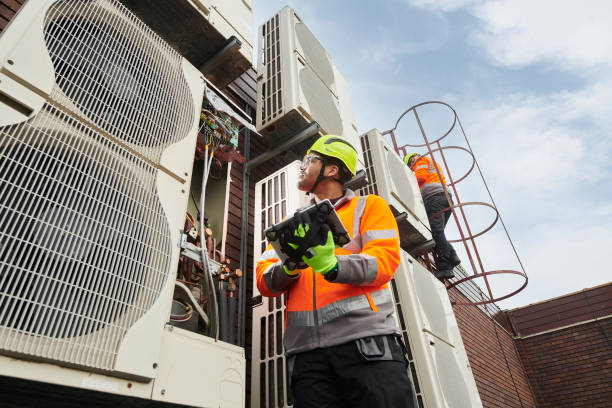Exploring the Latest Innovations in Heating and Air-Conditioning Technology
Innovation in energy efficiency, indoor comfort, and climate change mitigation depend on heating, ventilation, and air conditioning (HVAC) technology advances. The industry is seeing a wave of ground-breaking developments aimed at transforming how we heat and cool our buildings as the demand for HVAC solutions grows due to urbanization, population growth, and rising temperatures. This article explores the most recent developments in HVAC technology, emphasizing its effects on the user experience, efficiency, and sustainability. Examples of these developments include smart thermostats and sustainable heating solutions.
Daftar Isi
Integration between IoT and Smart Thermostats
The widespread use of smart thermostats and their Internet of Things (IoT) integration are among the most noteworthy developments in HVAC technology. With sensors, machine learning algorithms, and connectivity, smart thermostats can precisely regulate the temperature, maximize energy efficiency, and improve user comfort.
With the help of these gadgets, consumers may conveniently and more freely monitor and control their HVAC systems from a distance using smartphone apps. Furthermore, over time, smart thermostats may learn user preferences and make automatic settings adjustments to improve comfort and minimize energy use.
Integration with IoT platforms makes it possible for interoperability with other smart systems and devices in the building, further enhancing the capabilities of smart thermostats. Building settings may be more holistically controlled and optimized because of this interoperability, significantly reducing energy use and raising comfort levels.
Systems with Variable Refrigerant Flow (VRF)
Unlike conventional HVAC systems, variable refrigerant flow (VRF) systems offer greater energy economy, accurate temperature management, and variable zoning options. VRF systems are a paradigm leap in HVAC technology. VRF systems maximize performance and save energy by matching specific rooms’ heating and cooling loads through variable-speed compressors and refrigerant flow management.
The capacity of VRF systems to heat and cool different zones within a building simultaneously minimizes energy waste and provides individualized comfort. This is one of the system’s main advantages. VRF systems are also perfect for both new construction and retrofit applications because of their silent operation, small footprint, and simplicity of installation.
Furthermore, a greater range of building types and climates are using these systems because of developments in VRF technology, including simultaneous Heating and Air-Conditioning modes and enhanced heat retrieval. Because of this, VRF systems are quickly taking the lead in HVAC solutions for residential, commercial, and institutional buildings, looking for the highest levels of comfort and efficiency.
Technology of Heat Pumps and Electrification
Heat pump technology’s increasing efficiency, performance, and environmental effects contribute to its renaissance as a sustainable heating and cooling option. Heat pumps can be used for heating and cooling because they transport heat energy through refrigerant cycles between indoor and outdoor environments.
Because heat pumps can provide more heating or cooling energy than they consume in electricity, one of their key advantages is their great energy efficiency. Innovations like sophisticated heat exchangers, integrated heat recovery systems, and variable-speed compressors further increase this efficiency.
Additionally, heat pumps help the environment by lowering greenhouse gas emissions and mitigating climate change by eliminating the need for fossil fuels for heating and cooling. Heat pumps are key to the global shift towards a more sustainable and decarbonized energy future as heating becomes increasingly electrified.
Integration of Renewable Energy
Innovations in HVAC systems that incorporate renewable energy sources like solar, geothermal, and wind power also contribute to sustainable development and energy independence. Buildings can minimize their dependency on grid electricity, cut operating expenses, and lessen their carbon footprint by utilizing renewable energy sources to power their heating and cooling systems.
For instance, solar thermal systems heat air or water using sunlight, which can be utilized for absorption cooling, space heating, or water heating. Similarly, ground-source heat pumps use the earth’s constant temperature to deliver effective heating and cooling all year round, regardless of the weather.
Furthermore, by providing on-site energy management and demand flexibility, advances in energy storage technologies—such as thermal storage and battery systems—are improving the integration of renewable energy with HVAC systems. Buildings can optimize energy use and lessen their dependency on the grid by storing excess energy from renewable sources during low demand and deploying it at peak demand.
In summary
Changes in user preferences, sustainability requirements, and technological innovation are driving a significant revolution in the HVAC industry. The most recent developments in HVAC technology, such as heat pumps, variable refrigerant flow systems, smart thermostats, and the integration of renewable energy, are changing how we heat and cool our buildings.
To stay competitive and tackle the issues posed by climate change, stakeholders in the HVAC sector need to embrace these advances as the demand for comfortable, sustainable, and energy-efficient indoor settings grows. Buildings can achieve greater performance, lessen their environmental impact, and improve occupant comfort by utilizing the most recent developments in HVAC technology. This opens the door to a more resilient and sustainable built environment.



